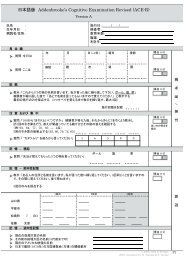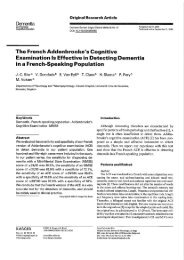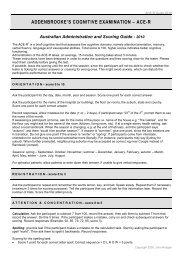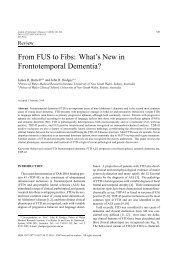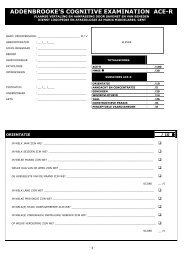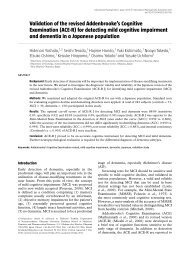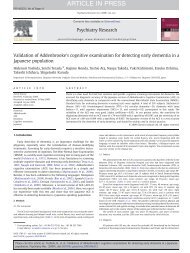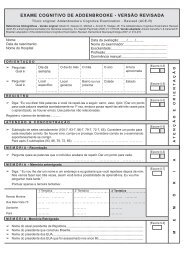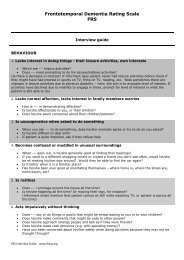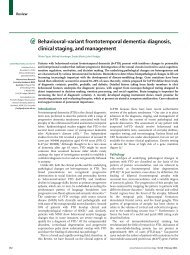Neurocase The Cambridge Semantic Memory Test Battery ...
Neurocase The Cambridge Semantic Memory Test Battery ...
Neurocase The Cambridge Semantic Memory Test Battery ...
You also want an ePaper? Increase the reach of your titles
YUMPU automatically turns print PDFs into web optimized ePapers that Google loves.
Downloaded By: [University of New South Wales] At: 01:21 23 April 2010<br />
production of their names, plus the ability to<br />
organise a search of semantic memory and to keep<br />
track of instances already retrieved. As all three<br />
types of patients assessed here typically achieve<br />
significantly better scores on letter than category<br />
fluency (e.g., Rogers, Ivanoiu, Patterson, & Hodges,<br />
2006), it seems unlikely that their deficits in category<br />
fluency are mainly attributable to executive dysfunction<br />
(e.g., search strategies). Given the growing<br />
evidence for attention/executive dysfunction very<br />
early in the course of AD (e.g., Amieva et al., 2004;<br />
Perry & Hodges, 1999; Pignatti et al., 2005), however,<br />
it seems likely that semantic, episodic and attention<br />
deficits all contribute to the category fluency deficit<br />
for AD and MCI seen here and in previous studies. In<br />
contrast, the category fluency deficit in SD may have<br />
a more unitary source in a central semantic memory<br />
deficit. This is consistent with the finding that the SD<br />
patient group were impaired relative to controls and<br />
both the MCI and AD patient groups on measures of<br />
picture naming, word–picture matching, and picture<br />
and word sorting.<br />
On the sorting task, all participant groups were<br />
characterised by a pattern of superordinate ≥ basic<br />
≥ subordinate, with the SD patients being impaired<br />
at all levels. This is consistent with previous studies<br />
investigating the degradation of conceptual knowledge<br />
in SD (Crutch & Warrington, 2008; Hodges<br />
et al., 1992; Hodges, Patterson, & Tyler, 1994;<br />
Lambon Ralph et al., 2007; Patterson & Hodges,<br />
2000; Rogers & Patterson, 2007). Furthermore, the<br />
stronger picture > word advantage in the SD<br />
group (see Figure 3) is also predictable on the<br />
basis, described earlier, of the more systematic<br />
semantic mapping between objects and meaning<br />
than words and meaning.<br />
<strong>The</strong> SD cases were impaired on a two-alternative<br />
forced choice test of semantic association (PPT) as<br />
well as the newer four-alternative 64-item version<br />
of this task (CCT). As mentioned in the Introduction,<br />
a few previous studies have reported that patients<br />
with mild SD are not always impaired relative to<br />
controls on the PPT (e.g., Nestor et al., 2006), but<br />
the current SD patient sample had reliably lower<br />
scores than both the control and MCI groups on<br />
both PPT and CCT. Although not reported here,<br />
additional correlation analyses confirmed that SD<br />
scores on the PPT and CCT were significantly<br />
associated with performance on the word–picture<br />
matching and the naming tasks, measures commonly<br />
reported to estimate severity of semantic degradation<br />
(Patterson et al., 2006; Woollams, Lambon Ralph,<br />
Plaut, & Patterson, 2007).<br />
CAMBRIDGE SEMANTIC MEMORY TEST BATTERY 11<br />
<strong>The</strong> CCT was designed (a) to extend and/or<br />
improve on the PPT by taking advantage of the<br />
features entering into choice of the 64 items used in<br />
the CSM battery (i.e., half living and half manmade<br />
objects, matched for familiarity in one subset and<br />
age of acquisition in the other, using the same<br />
items across different tasks), and (b) to be more<br />
difficult than the PPT by virtue of a chance level of<br />
performance of .25 rather than .5. It was not possible<br />
to analyse differences in the magnitude of the<br />
impairment in SD patients relative to controls in<br />
these two tasks due to the control group scoring at<br />
ceiling on the PPT; therefore the relative sensitivity<br />
of the two tasks (PPT vs. CCT) to semantic memory<br />
deficits was not directly assessed. Furthermore,<br />
although the performance of the MCI and AD<br />
patient groups indicated impairments relative to<br />
controls on the word version of the PPT but not<br />
the CCT, these findings are likely to be influenced<br />
by ceiling effects in the control group on the PPT<br />
and the inclusion of covariates in the CCT analysis<br />
(age at test, years of education). <strong>The</strong> addition of<br />
covariates also appears to account for the lack of<br />
significant impairment in the SD group compared<br />
to AD patients on the word version of the CCT<br />
(i.e., when analysed without covariates, the SD<br />
patients are impaired relative to the MCI and AD<br />
groups on both the word and picture versions of<br />
the CCT). It is possible that, with better matched<br />
samples and improved control data, the CCT<br />
might prove to be a more sensitive measure of<br />
semantic deficits, particularly early in the course of<br />
SD. It is, of course, not the only form of receptive<br />
test sensitive at an early stage (see for example the<br />
use of a synonym judgement task in Jefferies,<br />
Patterson, Jones & Lambon Ralph, 2009), but the<br />
CCT does have the advantage of being applicable<br />
in both verbal and non-verbal format.<br />
A simple test or battery of tests that reliably<br />
differentiates MCI and AD from SD would clearly<br />
be of value to both clinical and research practice.<br />
<strong>The</strong> relatively small samples of AD and MCI cases<br />
assessed here hinders evaluation of the efficacy of<br />
the CSM battery, in combination with the background<br />
neuropsychological test battery, to classify<br />
the performance of individual patients. Instead this<br />
study suggests that, despite some semantic memory<br />
impairment in AD (e.g., Adlam, Bozeat, Arnold,<br />
Watson, & Hodges, 2006; Hodges & Patterson,<br />
1995) and episodic memory difficulties in SD (e.g.,<br />
Scahill et al., 2005), the two groups can be differentiated<br />
when measures of the two types of memory<br />
are combined with measures of visuospatial ability.



